 Narsey Narsey Most political parties are focusing on the importance of the “youth” vote in the 2014 Elections. So what are the facts about the youth defined as those aged 18 to 34? I give some indicative numbers using my own population projections from the 2007 Census data. How many voters? Ethnic shares of voters Table 1 indicates my estimate of the total number of voters in 2014: some 588 thousands (give or take a few thousand). Table 1 also indicates that while the Fijian share of total population is estimated to be 60% in 2014, their share of voters (aged 18 and over) is a slightly lower 56%. Conversely, the Indo-Fijian share of Total Population was 34% but of voters was 38%. This is a reflection of the much higher proportion of the Fijian population who are below the age of 18 because of the historically higher birth rate of Fijians for the last four decades. The “Youth” vote and the “Elderly” Vote The political focus on the “youth” vote is justified by the population projections. Table 3 indicates that 41% of the voters are aged between 18 and 34. What exactly are the political parties offering the youth, especially those who come out of school and do not obtain paid employment? What about the elderly? But note also that some 21% of the voters are over the age of 54. This is very large percentage of voters whose needs from Government are quite different from the main voting group. What exactly are the political parties offering to improve the welfare of the elderly? Ethnic perspectives on Youth and Elderly Table 3 gives an interesting ethnic dimensions of the different age groups. Of the youth voting group, indigenous Fijians comprised 61% while Indo-Fijians comprised 33%. | On the other hand, Indo-Fijians comprised 43% of the elderly, which is somewhat higher than their share of both the voters and the population. The next 10 Years: the declining Indo-Fijians. The Fiji public are now well aware of how fast the Indo-Fijian population share is dropping because of emigration and lower birth rates. Few are aware of how far the changes have occurred at the lower age levels, for instance, at the Class 1 age group (6 years of age) and will occur over the next ten years. By 2024, the Indo-Fijian share of voters will have declined to about 30%. These changes are also taking place but much faster, in school enrolments. Already people are aware that formerly Indo-Fijian dominated secondary schools (like Jay Narayan College in Suva) have become totally dominated by indigenous Fijians. This trend is far more powerful at the primary school levels. The share of Class 1 enrolment will have declined from the already low 26% in 2014, to a mere 18% in ten years time: ie Fijians will be 75% of all Class 1 enrolment in ten years time. All formerly Indo-Fijian dominated primary schools will become dominated by indigenous Fijian enrolment, or have to shut down. One important corollary of the above population projections is that over the next decade or so, Indo-Fijians will be requiring less and less of total public resources made available by Government for education, health, and other public goods. I have written about this previously in the Fiji Times, that while population growth is seen as a “time bomb” in most developing countries, in Fiji it is the opposite, as far as race relations are concerned (available here). https://narseyonfiji.wordpress.com/2012/03/28/fijis-population-is-not-a-time-bomb-the-fiji-times-27-sep-2002/ I had also argued with political parties a decade ago, that there was little point in basing poverty alleviation policies on race, as both major ethnic groups were equally poor, and poverty alleviation based on need alone, would fairly give the majority share to indigenous Fijians. https://narseyonfiji.wordpress.com/2012/03/17/poverty-and-affirmative-action-facts-not-prejudices-the-fiji-times-11-june-2007/ |
|
2 Comments
I-Taukei
14/3/2014 01:19:41 am
And yet the racists are still hell-bent on race-based schoalrships:
Reply
Dreu
15/3/2014 11:43:56 am
If split of scholarship was 80 itaukei and 720 others then there is a need for return of itaukei scholarship. The majority ethnic group being pushed further down the ladder of opportunities is a recipe for future social unrest. We need to mitigate against these and we do this by being responsible and sensible policy makers. Ethnic conflict is evident all over the world and these kind of situations fuel it. Itaukei will never catch up academically with Indians or Part-European in terms of numbers surpassing their counterparts in excellence in marks. But we don't need to be foolish by turning a blind eye to something that could create future social unrest by ensuring the gap does not get wider so that future politicians, military or traditional leaders use the situation to create social unrest or even worse back to coups.
Reply
Your comment will be posted after it is approved.
Leave a Reply. |
[email protected]ARCHIVES
September 2020 August 2020 July 2020 June 2020 December 2018 November 2018 October 2018 January 2018 December 2017 November 2017 October 2017 September 2017 August 2017 July 2017 June 2017 May 2017 April 2017 March 2017 February 2017 January 2017 December 2016 November 2016 October 2016 September 2016 August 2016 July 2016 June 2016 May 2016 April 2016 March 2016 February 2016 January 2016 December 2015 November 2015 October 2015 September 2015 August 2015 July 2015 June 2015 May 2015 April 2015 March 2015 February 2015 January 2015 December 2014 November 2014 October 2014 September 2014 August 2014 July 2014 June 2014 May 2014 April 2014 March 2014 February 2014 January 2014 December 2013 November 2013 October 2013 September 2013 August 2013 July 2013 June 2013 May 2013 April 2013 March 2013 February 2013 January 2013 December 2012 October 2012 September 2012 |






